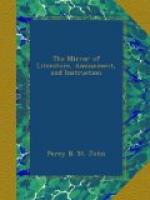THE MIRROR OF LITERATURE, AMUSEMENT, AND INSTRUCTION.
Vol. 20 No. 575.] Saturday, November 10, 1832. [Price 2d.
* * * * *
[Illustration]
Framlingham castle.
Castle of Ancient Days! in
times long gone
Thy lofty halls in regal splendour shone!
Thou stoodst a monument of strength sublime,
A Giant, laughing at the threats of Time!
Strange scenes have passed within thy
walls! and strange
Has been thy fate through many a chance
and change!
Thy Towers have heard the war-cry, and
the shout
Of friends within, and answering foes
without,
Have rung to sounds of revelry, while
mirth
Held her carousal, when the sons of earth
Sported with joy, till even he
could bring
No fresh delight upon his drooping wing!
James bird.
(From a Correspondent.)
This Castle is said to have been founded by Redwald, or Redowald, one of the most powerful kings of the East Angles, between A.D. 599 and 624. It belonged to St. Edmund, one of the Saxon monarchs of East Anglia, who, upon the invasion of the Danes, fled from Dunwich, or Thetford, to this castle; from which being driven, and being overtaken at Hegilsdon, (now Hoxne, a distance of twelve miles from Framlingham,) he was cruelly put to death, being bound to a tree and shot with arrows, A.D. 870. His body, after many years, was removed to a place called Bederics-gueord, now St. Edmund’s Bury. The castle remained in the hands of the Danes fifty years, when they were brought under the obedience of the Saxons. William the Conqueror and his son Rufus retained the Castle in their own possession; but the third son of William, Henry I., granted it, with the Manor of Framlingham, to Roger Bigod.—The castle continued in this family till Roger Bigod, the last of the race, and a man more turbulent than any of his predecessors, was compelled to resign it to King Edward I.; Edward II. gave it to his half-brother, Thomas Plantagenet, surnamed De Brotherton; from whom it descended to Thomas de Mowbray, twelfth Baron Mowbray, created Duke of Norfolk 29th of September, 1397. From the Mowbrays it descended to the Howards, Dukes of Norfolk, Sir Robert Howard having married Margaret, daughter of Thomas Mowbray, first Duke of Norfolk. His son, John Howard, was created Earl Marshal and Duke of Norfolk, 28th of June, 1483. He was slain at Bosworth Field, 1485; and his son, Thomas, Earl of Surrey, being attainted, the castle fell into the hands of King Henry vii., who granted it to John de Vere, thirteenth Earl of Oxford, from whom it again returned to the Howards. Thomas Howard, third Duke of Norfolk, being attainted, (38 Henry viii. 1546,) it was seized by the king, who dying the same year, his successor, Edward vi., granted it to




